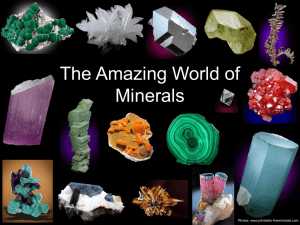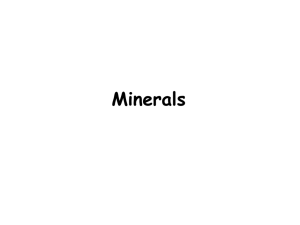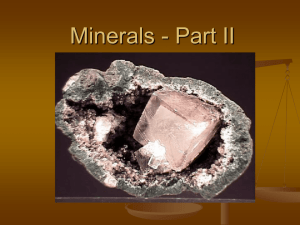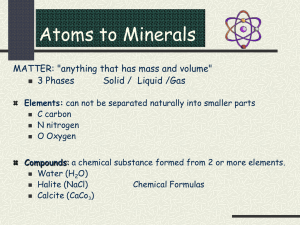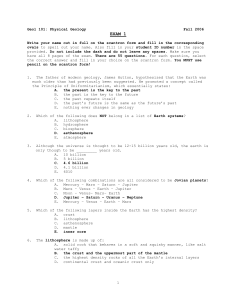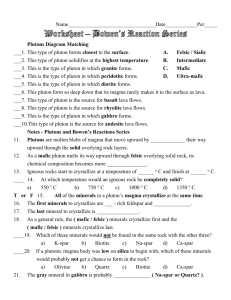ondernotes NATURal Science II Geology 1st Sem, 1st Exam
advertisement
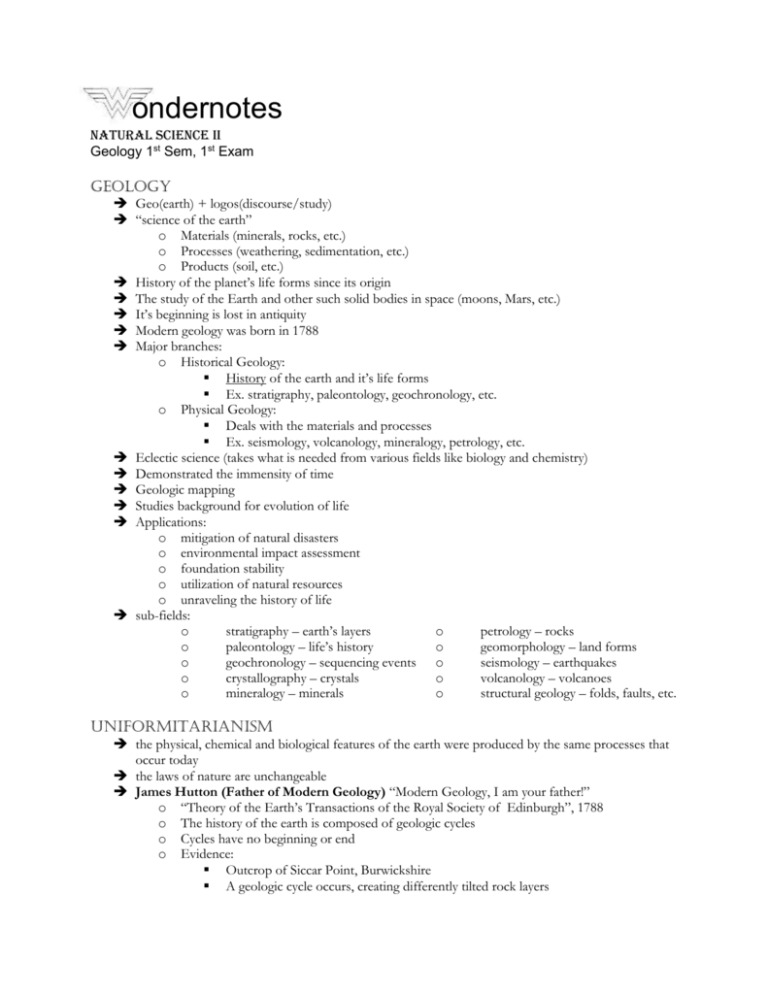
ondernotes NATURal Science II Geology 1st Sem, 1st Exam Geology Geo(earth) + logos(discourse/study) “science of the earth” o Materials (minerals, rocks, etc.) o Processes (weathering, sedimentation, etc.) o Products (soil, etc.) History of the planet’s life forms since its origin The study of the Earth and other such solid bodies in space (moons, Mars, etc.) It’s beginning is lost in antiquity Modern geology was born in 1788 Major branches: o Historical Geology: History of the earth and it’s life forms Ex. stratigraphy, paleontology, geochronology, etc. o Physical Geology: Deals with the materials and processes Ex. seismology, volcanology, mineralogy, petrology, etc. Eclectic science (takes what is needed from various fields like biology and chemistry) Demonstrated the immensity of time Geologic mapping Studies background for evolution of life Applications: o mitigation of natural disasters o environmental impact assessment o foundation stability o utilization of natural resources o unraveling the history of life sub-fields: o stratigraphy – earth’s layers o petrology – rocks o paleontology – life’s history o geomorphology – land forms o geochronology – sequencing events o seismology – earthquakes o crystallography – crystals o volcanology – volcanoes o mineralogy – minerals o structural geology – folds, faults, etc. UNIFORMITARIANISM the physical, chemical and biological features of the earth were produced by the same processes that occur today the laws of nature are unchangeable James Hutton (Father of Modern Geology) “Modern Geology, I am your father!” o “Theory of the Earth’s Transactions of the Royal Society of Edinburgh”, 1788 o The history of the earth is composed of geologic cycles o Cycles have no beginning or end o Evidence: Outcrop of Siccar Point, Burwickshire A geologic cycle occurs, creating differently tilted rock layers The present is the key to the past! The Earth changes, but only in accordance to unchanging physical laws Uniformity of process but not of rate, time, nor place of occurrence CATASTROPHISM Earth’s history is a series of catastrophes Each catastrophe exterminated existing life Baron Georges Cuvier o Six major catastrophes (6th = Great Deluge [Noah’s Ark]) o Evidence: Paris Basin layers of fossils, where fossils in one layer no longer in the next DISPROVED – in other places, fossils are mixed! THE UNIVERSE All energy and matter that exists Big Bang (14-15 BYA) o Event filling all of space with the particles of the embryonic universe rushing away from each other Nebular Hypothesis o Solar system from nebula(cloud of gas and dust) o Contracts to a rotating disk heated by gravitational energy converted to thermal energy o Cooling results in the formation of rocky and metallic materials condensing into smaller particles o Collisions caused merging, and change of size from dust size to asteroid size o Fragments accrete to form planets EARTH’s sIZE And sHAPE Eratosthenes – Greek mathematician, geographer, astronomer o Geodesy – branch of applied math dealing with the measurement of large areas or the Earth using variations in gravity and the distance of known points o Observations: Shorter shadows at the equator Alexandria well – part in shadow during summer solstice Aswan(Syene) well – no shadow in well at noon Alexandria is 925 km north of Aswan o Assumptions: The sun is so distant, its rays on both places are parallel A plane passing through Aswan, Alexandria, and the noon sun would pass through the center of the earth The plumb line points directly towards the earth’s surface The east and west walls of Alexandria lie on the north-south planes The earth is a sphere o Conlusion: [𝑑𝑖𝑠𝑡𝑎𝑛𝑐𝑒(𝑎𝑠𝑤𝑎𝑛−𝑎𝑙𝑒𝑥𝑎𝑛𝑑𝑟𝑖𝑎) ][3600 ] Polar circumference = [𝑎𝑛𝑔𝑙𝑒 𝑜𝑓 𝑠𝑢𝑛′ 𝑠 𝑟𝑎𝑦𝑠 𝑡𝑜 𝑡ℎ𝑒 𝑣𝑒𝑟𝑡𝑖𝑐𝑎𝑙] = 450k ~ 470k km 14% larger than true measurement (40,008 km) Why? o Assumption that Alexandria is directly north of Aswan o Aswan is not precisely upon the Tropic of Cancer 17th and 18th century o Eratosthenes’ method was resurrected o north – south lines or arcs of meridian were measured at different latitudes(Finland, France, Peru) o when compared, latitude in Finland > latitude in Peru why? Because Earth is not a sphere, it is an oblate spheroid International Union of Geodesy and Geophysics (1967) o Polar diameter – 12,713.54 km o Equatorial diameter – 12,756.32 km o Polar circumference – 40,008.00 km o Equatorial circumference – 40,075.16 km THE EARTH’s OUTER LAYERs Atmosphere o 78% hydrogen, 21% oxygen, 1% argon, other gases o Original atmosphere Methane, ammonia, water, hydrogen What happened? (Anyare?!) – blown into space, swept away by solar wind o Second atmosphere Made from frozen gases trapped in Earth’s interior/chemical compounds in rocks Released through outgassing by volcanoes, fissures, fumaroles Water vapor, carbon dioxide, carbon monoxide, nitrogen, hygrogen Where did oxygen come from? Primitive photosynthesis by cyanobacteria Water vapor became O2 through photochemical dissociation (chemical action of light) Existing O2 reacted with ammonia and methane, producing more oxygen Where did liquid H2O come from? Water vapor -> clouds -> precipitation Hydrosphere o Earth – blue planet/water planet o Water is in constant motion (hydrologic cycle) o Global ocean Most prominent feature of earth 70.8% (361,059,000 km2) of earth’s surface 98% of all earth’s water * land makes up 29.2% (148,892,000 km2) of surface Northern hemisphere 4/5 land, land hemisphere Southern hemisphere 1/10 land, water hemisphere Biosphere o All life on earth o Exists in a narrow zone extending from photic zone to snowline in mountains Photic zone – sunlit area of ocean, 200-300 m below sea level Snowline – 6000 m above sea level o Factors contributing to distribution: Temperature, pressure, chemistry o Without life, the make-up and nature of other spheres would be different o Latitudinal control (due to tilt) High altitude – warm water Low – mid latitude – cold water CONTINENTS Roughly triangular Concentrated in Northern Hemisphere Appear to be remarkably flat 3 major structural components o Basement complex/shield Completely deformed rocks eroded down to sea level Ex. Canadian shield o Stable platform Basement complex covered by layer/veneer of sedimentary rock Ex. Nashville, Tennessee o Folded mountain belts Ex. Appalachian mountains Less dense than ocean basin Old – 3.8 BYA Climatic zone determines the type/style of landforms Granite, silicon, etc. OCEAN BASINS Previously thought as nondescript Oceanic crust o Mostly basalt – denser simatic(Si + Mg) crust o Holds the key to the evolution of the earth’s crust o Young in the geologic time frame (150 MYA) Major provinces o Oceanic ridge system Most prominent mountain range on earth Formed from layers of molten rock Ex. Mid-Atlantic ridge/East Pacific rise o Trenches Relatively narrow and extremely deep grooves/depressions Occurs in subduction zone Ex. Philippine trench o Abyssal floor Vast area of broad, smooth deep ocean floor on both sides of ridges Harsh conditions = less diverse life EARTH’s InTERIOR Information obtained from: o P waves – move through all media o S waves – solid medium only Layers: o Crust Felsic/mafic 5-40 km thick o Mantle Mafic 2885 km thick Heterogeneous ~2.9 g/cm3 Homogeneous (Mg,Fe)SiO3 / (Mg,Fe)O ~3.5-5.5 g/cm3 o Core Layered Upper mantle o Dunite – ultramafic igneous rock (olivine) o Peridotite – ultramafic igneous rock (pyroxene/olivine) o Eclogile – mafic metamorphic rock o Chrondite – unmodified rock from meteorites Transition zone Lower mantle Rich in Fe Minor amounts of S, Si, O, C, Ni ~5.5-13 g/cm3 2 regions Outer core – liquid, 2270 km thick, possible origin of magnetic field Inner core – solid, 1216 km radius Regions o Lithosphere Slab of rock, variable thickness Upper boundary – crust Lower boundary – asthenosphere Mohorovicic Discontinuity o Asthenosphere Low velocity zone (of seismic waves) Zone of partial melting Upper upper mantle Discontinuities o Mohorovicic Discontinuity Boundary of crust and mantle Phase change from lower crustal to mantle rocks Basic to ultrabasic rocks o Gutenberg – Wichert Discontinuity Boundary between mantel and core Heat sources o Radioactivity of uranium, thorium, potassium o Conversion of gravitational energy to thermal energy o Reduction in pressure Sample Features: o Seamount – formed when molten oceanic crust seeps through crustal fractures o Islands - formed when the top of a seamount breaks the surface of the water o Guyot – seamounts whose peaks are eroded / ‘flat top’ o MINERALS Naturally occurring, Homogeneous, Inorganic Solid with ordered atomic arrangement / crystalline structure Definite chemical composition that may vary within ordered limits More than 4000 known minerals MINERALOID Naturally occurring amorphous substance Without crystalline structure / orderly pattern of elements CRYSTAL Regularly shaped object that reflect ordinary arrangement of internal structure POLYMORPHISIM Minerals having the same composition but different chemical structures Ex. Pyrite and marcasite (FeS2), calcite and aragonite (CaCO3), diamond and graphite (C) ALIASES / A.K.A.s Calcite Quartz Pyrite Olivine Uranite Adularia - Iceland spar Ice crystal Fool’s gold Peridot Pitchblende Moonstone OPTICAL PROPERTIES Pattern of reflected x-rays Double refraction o Ability to split a beam into two o Ex. Calcite PHYSICAL PROPERTIES Crystal form o General outward appearance o Groups of crystal faces which display the same physical and chemical properties due to similarity in arrangements o Law of constancy of interfacial angles Angles between equivalent faces of crystals of the same substance, meausured at the same temperature, are constant o Ex. Prismatic, cubic Crystal habit o External shape o Ex. Botryoidal, fibrous, granular Color (least diagnostic property, impurity) o Idiochromatic Inherent, unchangeable mineral color All minerals in the same group have the same color Ex. Muscovite (colorless), azurite (blue), sulfur (yellow) o Allochromatic Minerals with exotic variety of colors Ex. Quartz – amethyst (purple), citrine (yellow) Corundum – ruby (red), sapphire (blue), emery (black, grey) Luster o Quality and intensity of light reflected from mineral o Groups: Metallic – luster of untarnished metal Dark/opaque minerals (ex. Pyrite, gold) Non-metallic – usually colored minerals Resinous – like resin Adamantine – diamond Greasy – covered in oil Vitreous – glassy Silky – silk-like Earthy – dull Pearly – pearl-like Streak o Color of powdered/pulverized mineral o Most common = white o Ex. Hematite – reddish color, black streak; limonite – brown color, yellow streak Hardness o Ability of a mineral to withstand abrasion or scratching o Moh’s Scale of Hardness – True Geologists Can Fry An Old Quail To Certain Degree 1 2 3 4 5 6 7 8 9 10 o Talc Gypsum Calcite Fluorite Apatite Orthoclase Quartz Topaz Corundum Diamond Practical scale (kasi kalokohang dalhin ang mga samples ng Moh’s Scale) 2 – 2.5 3 5 – 5.6 6–7 7 Fingernail Copper coin Glass plate / knife blade Steel file Streak plate Cleavage o Characteristic tendency of minerals to split easily along certain planes o Governed by internal arrangement, type of bonding, atomic spacing o Cleavage table: Number Quality Example 1 Perfect mica 0 2 Very good at 90 feldspar Fair at 900 pyroxene Very good at 560/1240 amphibole 3 Cubic (perfect at 900) halite (salt) Rhombohedral (perfect at 750) calcite 4 Perfect diamond 6 perfect sphalarite Fracture o Nature of the surface formed by breaking in the direction other than that of cleavage o Types: Conchoidal – chipped off (like glass) Ex. Quartz Splintery – fibrous materials, resembles broken plywood Irregular – neither conchoidal nor splintery o Parting Breaking along planes of structural weakness Result of twinning or pressure Specific gravity 𝑤𝑒𝑖𝑔ℎ𝑡 𝑜𝑓 𝑎 𝑣𝑜𝑙𝑢𝑚𝑒 𝑜𝑓 𝑚𝑖𝑛𝑒𝑟𝑎𝑙 o SG = 𝑤𝑒𝑖𝑔ℎ𝑡 𝑜𝑓 𝑎𝑛 𝑒𝑞𝑢𝑎𝑙 𝑣𝑜𝑙𝑢𝑚𝑒 𝑜𝑓 𝑤𝑎𝑡𝑒𝑟 Measured by spring-scale/estimation Quartz 2.65 Ice 0.9 Feldspar 2.56 – 2.76 Gold 19.3 Galena ~7.5 Tenacity o Resistance of a mineral to breaking, crushing, bending, or tearing o Types: Brittle – breaks/powders easily Malleable – can be hammered into thin sheets Sectile – can be cut into thin shavings Ductile – can be drawn into wire Flexible – bends but does not return to original shape Taste o Halite(salt) = salty Smell o Clay minerals – earthy o Sulfuric – rotten eggs Feel o Talc – soapy o Graphite – greasy Magnetism o Magnetite (lodestone, bato balani) HCl (Hydrochloric acid) test o Carbonate – effervescence (fizz) Calcite Dolomite – no reaction because of Mg, but reaction can be induced in powder due to increased surface area for CaCO3 Double refraction – Ex. Calcite Fluorescence o Re-emission of absorbed light Striation o Presence of parallel, hair-like grooves along the surface of mineral o 8 MOST ABUNDANT ELEMENTS (CRUST) Oxygen Silicon Aluminum Iron Calcium Sodium Potassium Magnesium COMMON ROCK-FORMING MINERALS Quartz (felsic) Feldspar (felsic) Feldspathoids Mica (mafic) Pyroxene (mafic) Amphibole (mafic) Olivine(mafic) ADDITIONAL TERMS / NOTES: Silica tetrahedron – basic building block of crust Silicates – most abundant mineral group Feldspars – most abundant mineral Polymerization – process by which silica tetrahedron molecules share oxygen or metals Quartz –conchoidal fracture, 7 hardness Feldspar – 2 cleavage planes, 6 hardness o Plagioclase – grey to white, striation o K-feldspar – pink Olivine – green and granular Mica o Muscovite – light o Biotite – dark Pyroxene – 2 cleavage planes at 900 Amphibole – 2 cleavage planes at 540/1260 Granite – light, silicon, aluminum, felsic Basalt – dark, silicon, magnesium, mafic Acidity/Basicity: Acidic Basic Ultrabasic High SiO2 Low SiO2 Very low/absent SiO2 Granite Basalt Peridotite /gls07192011 Inspired kasi XD Credit goes to Jon Tiosin, kasi majority ng content galing sa Supernotes may konting annotations lang ako, at mga hirit na ewan kung may mali, sabihan niyo ako, para ma-edit ko pa




